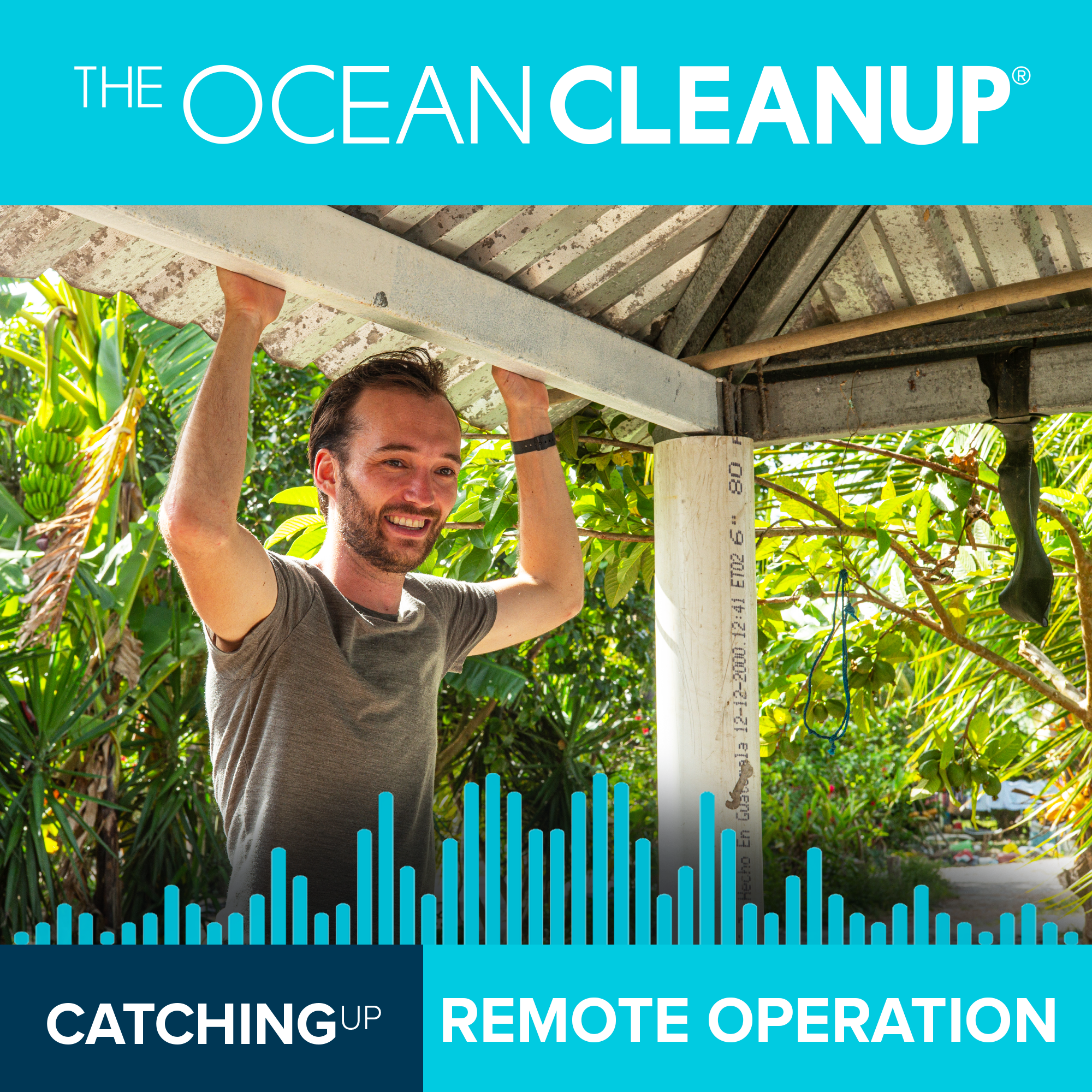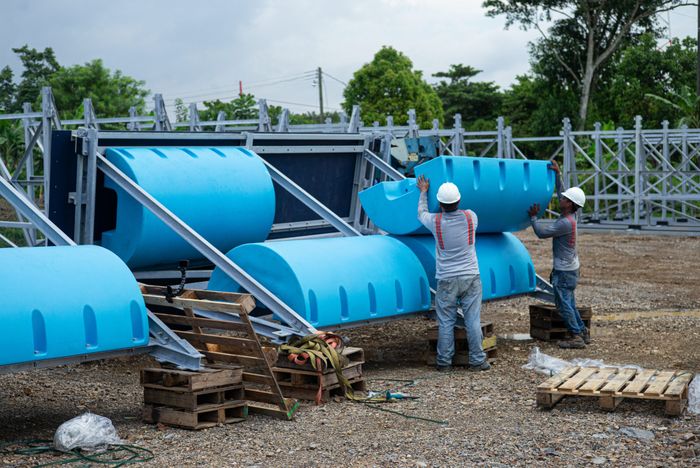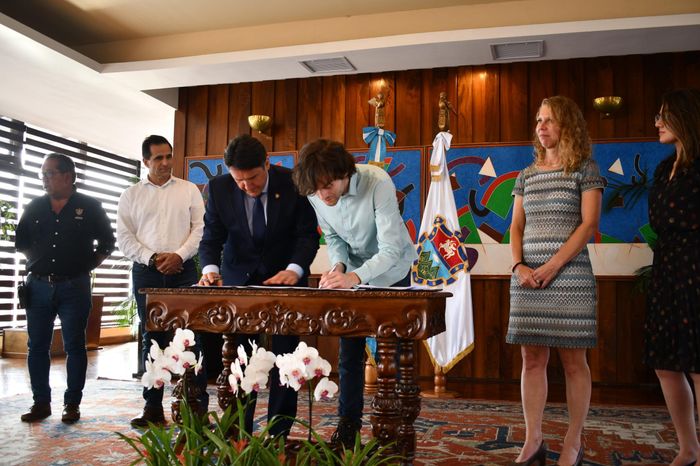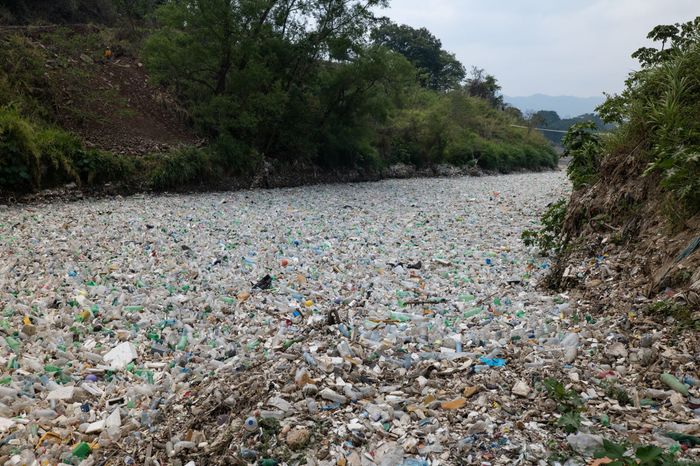
Rivers
Remote Operations | A River Solution on the Edge of Guatemala
This month’s podcast is from the remote and windy shore of the Rio Motagua. Robert Leijgraaf, aka Bobby, Project Engineer at The Ocean Cleanup, sits with our host, Dan van der Kooy, in the fishing village of El Quetzalito, Guatemala.
We’re about to deploy the second Interceptor Solution in Guatemala. Bobby talks about the need for another Interceptor Barricade at the end of the Rio Motagua and what we learned from the first project in the country. Interceptor Barricade XL will be about 300km downstream from the first Interceptor Barricade. If it all goes well, the combined impact of the two deployments will stop river pollution right before it enters the Caribbean Sea.
Learn more about our new deployment here.
Transcript
Disclaimer
The transcript has been edited for easier reading, excluding filler words and repetitions, adapting grammar and sentence structure.
Introduction
Dan: This is a nice little location. A lot of action, people sorting.
Bobby: Yep.
Dan: If you’ve listened to “Catching Up,” you know I often find myself in these fishing villages like La Ciénega in the Dominican Republic or Raytown in Jamaica. There are a bunch of them in Klang and Thailand on the Chao Phraya, but none of them are as remote as where we are standing right now on Rio Motagua, about 5 kilometers from the Caribbean Sea. To describe this place is virtually impossible, but I have a Dutch engineer with me today who is going to try to help me describe where we are and more importantly, why we are here and what we’re doing here. You’re going to hear noises because we are in a working fishing village, there’s going to be boats coming by with people who have gone out fishing or are going out fishing, and we’re also at the location of, well, Bobby, introduce yourself and tell me what’s happening here.
Bobby: I’m Bobby, or Robert officially. I’m an engineer at The Ocean Cleanup, for almost two years now. We’re at the Rio Motagua, one of the main rivers in Guatemala, and today we’re standing in El Quetzalito, a very remote village close to the border of Honduras. Our previous deployment is in the Rio Las Vacas, which is a tributary of this main river. This is one of the big rivers in Guatemala, and we are at the end of it, close to the river mouth. This village here happens to be at the river and for a long time it has been a fisherman’s village. When they built this place in the 80s, the river wasn’t even adjacent to the village, it was just meadows. The river is very free and meandering. I guess they got lucky, they’re right on the waterfront nowadays, and they’re not only fishing for fish, but also for plastics. That’s happening right behind us, some 40 people sorting plastics. These are the people who are employed by MARN (the Ministry of Environment), which is the primary reason we’re in this location because, in a lot of our other deployments, we are organizing the operations, but here it is organized by the Ministry of Environment, so all these people sorting here already are employed by the ministry so that’s a great advantage to us.
The location
Dan: When you say remote, we are 20 kilometers from the pavement, which is the nearest paved road, and that road is not even close to Puerto Barrios. As you said, you’re very close to Honduras, and it’s this random road that heads to Honduras. Then, all of a sudden, you see a dirt road, and you make a left. And when you make that left, the bumps, bruises, organs inside your body, and teeth, everything is shaking. The car is shaking, and you’re hitting potholes that are two feet deep by five feet wide and banana fields for miles and miles and miles. And then you come to this gem. Why are we here, Bobby?
Bobby: So this is where we will be deploying our next barrier. You’ve seen some images, and it’s going to be right here behind me. You see the conveyor belt. This village is where the Ministry of Environment built and constructed this sorting facility. They built a barrier, the one I am sitting on now; they built this whole facility to take out the plastic, sort it, and take it back to a proper place instead of leaving it to float into the ocean. Unfortunately, this barrier didn’t hold for that long, because this river can be pretty insane. Even though it’s a calm day today, it can get pretty wild out here. That’s why we are helping them build a new barrier. That’s what you’ve been seeing, we’ve placed some big anchors, and blue barriers, and that’s going to help these guys catch plastic again.
Interceptor 021 Barricade XL
Dan: For those keeping score, this is what we call Interceptor Barricade XL number 021. Give me some of the facts about this barricade and how we came to this. As you mentioned, we have Interceptor 006 in the Las Vacas just north of Guatemala City in San Antonio, Las Flores, which has been quite a success. And our relationship with Worthington that we worked with for this project up in Las Vacas, we’ve worked with them again on this. Right? But at a different scale from what I understand?
Bobby: Exactly. So, the scale part, if you compare this location to the one in Las Vacas, there are differences in how the river behaves. In Las Vacas, we have very intermittent flow, sometimes very violent, very extreme, and so there’s a big difference with this place, where it’s more graduate and equal throughout the year. It can grow quite a lot, but there’s always flow here, so there’s also always plastic. And because we’re at the very end of the river, there’s also a lot of plastic here, and the river is very wide. You can see all the tributaries end up here. So there’s approximately 110, 120 meters to the other side, so that requires a bigger barrier. Whereas in Las Vacas, it needs to be very sturdy because it’s bouncing around in turbulent water, sometimes resting on the riverbed; this one will always be floating, but also always be in the flow. So this one is of similar build but slightly larger, and there are a few structural changes. Those are the main differences, but the principle is the same. We have two very large marine anchors upstream and downstream that connect a chain and a cable to which all the elements are attached. Another difference is that this one has a very large front screen, and that’s needed because while in Las Vacas, you can reach the middle of the barrier with the excavator, but here, that’s impossible. So we must make sure that nothing sticks to the barrier; everything slides by the force of the flow to the sides. We’ll also have an excavator here taking it out, but we can’t go out onto the river to untangle stuff. So that’s why we have a smoother surface; that’s the idea behind it. Worthington is our design partner; they also manufactured it. They placed one of this type earlier, and it seemed to be working there. So this one will do its job for sure, the question is, how well will it do its job? It remains to be seen.
Dan: Stay tuned. Now, Bobby, explain to me that if we have closed the Las Vacas up in Guatemala City, why do we need this second intervention down at the mouth of the Motagua? Is there that much trash coming, 300 kilometers from Guatemala City to the mouth of the Motagua?
Bobby: There is. There are a couple of reasons, actually. So one of them is that in Las Vacas, the flash floods, as you see with the trash fence in the videos of 006, it can be so violent that the barrier can’t stop all. The barriers might overtop, the flow might push plastics under, so we lose stuff, unfortunately, and that all eventually ends up here. Another point is that we have other cities and other points of pollution along the 300-kilometer river stretch. So, even if we would catch everything in Las Vacas, there would still be debris floating down here. And there is the legacy plastic, the plastic that washes up at high tide on the river banks, and it might stay there for a month or a year, and 300 kilometers is long. So even if we were to close Las Vacas and stop all the incoming sources, there would still be quite a significant amount of trash coming with every high water level. So, we’re not done here yet, and it will be coming for some time. This is a good place because it’s very close to the sea. So there are no pollution points between here and the sea, which means that everything we catch here, that has no chance of going anywhere anymore. And hopefully, behind this barrier, we’ll get a clean river going into the sea. That’s the main advantage of being so remote in this place.
Dan: This is, of course, the first time we’ve ever put something of this scale in a river. So I’m certain that there’s things that will happen that we can’t even imagine yet, right?
Bobby: Probably. There always will be something that we need to adjust or align a bit more. Is the structure behaving as it should be? Is the location where it should be? We have an upstream and downstream part that needs to be aligned with the current structure you see behind here, the extraction point. If that’s not properly aligned, we might lose some plastics. So that’s going to be a very big focus point to make sure that the whole gap is closed; there’s nothing that can escape. But once it’s here, it must also not be loose when there’s a flush at night. Another one will be the boat passage. There are a lot of fishermen going in and out, and they need to be able to pass. Now, the water is pretty high or, let’s say, average today. In the dry season, it might get lower, and boats must still be able to pass. So that’s one that we’ll be looking at in the coming months. And, of course, the fishermen are probably very much involved in how this barrier will behave, and they’ll come up with all kinds of ideas. So it will probably be a big focus, talking with them, seeing how they see it behaves. They have been constructing their own barrier after this one failed, to continue catching plastic. It’s a livelihood for them now. So, I’m sure they’ll be very happy with this one, but if there’s anything not working, that will be a first starting point, to see what they think. If there’s anything not working or not working as they would like, we’ll work together to solve that.
"Competition"
Dan: Is that a 4Ocean team?
Bobby: I think so. Yeah.
Dan: That’s kind of a cool thing. We’re sitting here on the Motagua, we’re The Ocean Cleanup. We’re doing our thing on this river to rid the world’s oceans of plastic, but you go out about 5 kilometers to the mouth where it opens, and you’ve got this beach covered with trash. And you have all these 4Ocean bags all over the place because these guys are doing an incredible job cleaning up the legacy plastic out there. How important is that to our project as well? People often think, this is something that drives me crazy, people are always, oh, your competition for oceans, they’re doing this in the Motagua. And I sit there and I’m, like, competition? Are you kidding me? There is more than enough plastic for everybody. In fact, if that’s what we’re thinking, I’ll take more competition and more competition and more competition. There’s that much plastic. Right?
Bobby: I think competition is always good and especially good in our business. The more people, the more organizations doing what we’re doing, the sooner this problem is solved, I would hope so. So, yeah, it’s understanding that we’re not the only one in the river because the pollution is quite severe. So, I think it’s great that whatever is already out there gets cleaned as well, which is a lot.
Dan: And it’s cool to see these boats come back with all these bags of trash that 4Ocean is cleaning off the beaches. And it just shows there are a lot of people working on this.
Bobby: Yeah, definitely.
Idea turned reality
Dan: Take me back to the first time you saw this barricade built. What did it do for you? Because it’s beast, man.
Bobby: It’s always something special when you’ve been looking at drawings, and you can see a number and measure certain meters, and to see it in real life and get to touch it, it comes to life, and it puts things into perspective. It’s quite cool. But then again, this river is big so it will look properly in proportion once it’s in the water. But to see it, to touch it, it’s quite cool. It’s quite special. It’s so difficult to build it, get all the pieces here, and handle all the elements for this assembly; it’s been quite a lengthy process. Several weeks for sure. That’s just because of the size of these things and the complexity of moving big things, safely assembling them, and then transporting them to a remote location like this, it just takes time and a lot of precision. So it’s been quite cool to see that everything went well and that we made it work by being careful and precise.
Dan: Yeah. You talk about the scale when they’re sitting in the yard where they’re being assembled, they look massive. And when they’re in a river of this size, they look, you know, normal. But I think they looked the largest on a one-lane dirt road from Puerto Barrios to El Quetzalito. Especially one covered with palms on both sides, and this thing was squeezing through like a salami.
Bobby: You would almost think that we designed it for it, but that was actually not the case. That was a lucky coincidence, I suppose. Otherwise, we would have to bring them over the over the water. It was a tight fit, for sure!
Dan: What are you looking out for the most? What’s your biggest concern? What’s your biggest curiosity with this thing that worries you a bit?
Bobby: It’s funny because as long as this barrier is not assembled and not in the water, the only focus is on everything that still needs to be done to get it in the water. And little thought is spent on what happens after. Luckily, we have some colleagues who take care care of that. And, of course, I will be involved as well. But for now, it’s finalizing all the little details in the design and, you know, communicating properly about the problems that the contractors come up with and just making sure that everything works and we don’t lose too much time fixing it. So that’s my primary concern at this moment. After that, that’s when the project actually begins, and that’s where we’re going to start catching plastics. That’s going to be beautiful. I remember the first time I saw it in Las Vacas, and that’s quite magical when there’s nothing else to do. You just wait and see the plastic coming, and I hope to see that here as well soon in a month. I think the great part here is last year we were very much alone doing it. Here, we have this whole community, these 400 people living here and working. So they’re also super excited, so it’s going to be a big feast the moment this thing’s done and in the water. It’s going to be quite spectacular.
What makes this project unique
Dan: Something that’s interesting about this barricade is the fact that it is going across the river. But we’re in a fishing village, and we have people like 4Ocean bringing trash back and forth, and we have boats going back and forth. What is unique about this one?
Bobby: So it is possible to open it, so boats can always pass even when it’s fully deployed. In a situation where there is an issue or maintenance needs to be done, we have the possibility to open the barrier manually. There’s also a safety link that breaks if the force becomes too high. It’s not likely to happen, but in case there’s a hurricane or the river grows so much, at least nothing will get damaged, and the barrier will open up on the downstream point and move to the other side of the river where it safely rests. That can also be done manually if there’s anything that needs to be checked. So that will also be a focus point after installation when we train these guys how to safely do that and also how to safely reconnect after it’s opened. You need to pull it in against the [river] force, so it will require a winch and some other equipment. So that will be a small training for the crew here.
Dan: It’s cool because when you see drone shots of these things, I’m thinking even in Santo Domingo with Interceptor 004, you see it and you think, oh, it’s so simple. It’s just connected to land, then it’s connected to the source that pulls the waste out of the water. But there actually is a lot of engineering that goes into these barriers, right?
Bobby: Yeah. So there are some different connecting points, and they need to be strong enough, but they also need to be balanced in such a way that the barrier is still floating upright in most situations. And that’s the difficult part: we have high flow, high water level, low flow, low water level, and everything in between and combined. So it’s always a bit of a compromise to find a way that works best in all of those cases. But there are indeed several connecting points. For example, we have one big chain coming from the anchors with a connecting beam going to 2 cables, and on the other side, the same. So all these connecting pieces were custom made, and they seem to be working well and as they should, which we’ll continue looking at to make sure that they hold up strong.
Motivation and the strength of a great team
Dan: How did you get into engineering? What was the process like for you as a kid growing up? Were you like, “One day, I want to build barricades and stick them in rivers?”
Bobby: Yeah. I guess, you have many dreams as a kid. I have always liked building, designing, and drawing. So I guess that was something that I wanted to do when growing up. I studied civil engineering, so that’s more of the infrastructural side of engineering. It’s funny how you move through life, I suppose, but, I worked at different engineering companies as well. But I always hoped to find a place where you could make a big impact and see a result. And, honestly, I don’t know any other organization that will be better than here where, you know, the problem is so prevalent, and the solution is so reachable, and within a year, you can have another deployment. From brainstorming to reality, that’s incredible, and being part of the whole process is quite special, I think. So, it’s a lucky find, I suppose.
Dan: Well, it’s been amazing to watch, man. The last 2 years watching you on this project and the Rio Las Vacas, I mean it when I see the look on your face. I do this with all the projects whether I’m in Bangkok or Dominican Republic or Los Angeles. When the engineers see it come together, they have a different look on their faces than when they are sitting in an office in Rotterdam. And it’s so cool to get to watch that, record it, and put these stories together. It’s so interesting, too, because you have so many different types of people that come to these builds and these deployments because you have operations managers, you have construction guys, you have camera guys like me out there with cameras, and you mix all these personalities, and then you throw in engineers, and you all go to dinner at night, and you sit there and its a stew of human brain that just comes together. I love the stories and the bouncing around and how it all works, it’s super cool at this place.
Bobby: Exactly. And that’s the thing. Right? It’s no one person or no one endeavor. It’s really a combination, an iteration, and a whole process. And, it’s helped so much that everybody is so incredibly motivated towards the same goal. You don’t have different ideas. The objective is very clear, so it’s very clear how you can contribute to getting there. It’s really amazing indeed, like you say, the people and the ideas that you have together to form a solution. That’s quite inspiring, I guess.
Dan: Cool. Well, from El Quetzalito on the Rio Motagua at the mouth where it meets the Caribbean, I’m Dan van der Kooy. I’m here with Bobby, the head engineer on this project. And this thing is being deployed right now. Keep following us with this project, keep following us with 006 up in Guatemala City. This one’s a big one for The Ocean Cleanup. I think in terms of scale, out of what we’ve deployed in a river so far, this is by far the largest barricade that we have dealt with. So it’s going to be super cool to watch this over the next months and see how it kind of shapes itself. Thanks for everything, keep listening to us, keep supporting us, and adios.






